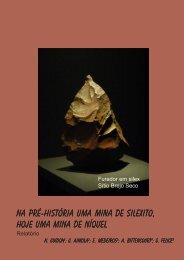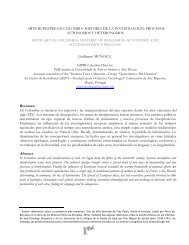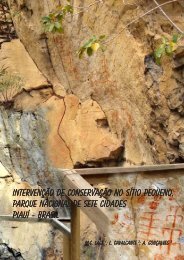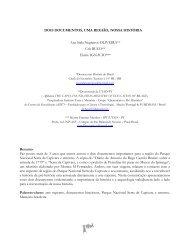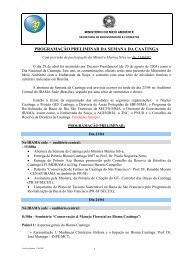Untitled - Fundação Museu do Homem Americano
Untitled - Fundação Museu do Homem Americano
Untitled - Fundação Museu do Homem Americano
Create successful ePaper yourself
Turn your PDF publications into a flip-book with our unique Google optimized e-Paper software.
Global Rock Art Congress<br />
29 Junho – 3 de Julho 2009<br />
Vandalism, graffiti or ‘just’ rock art? The case of a very recent ‘engraving’ in the Côa Valley<br />
rock art complex (Portugal)<br />
António Pedro Batarda Fernandes , Portugal<br />
A vandalism/graffiti/engraving episode occurred October 2001 in a Côa Valley rock art panel in which<br />
a hunter from the region engraved a motif (a defecating horse) superimposing two previously existing<br />
prehistoric engravings (one from the Upper Palaeolithic, the other from the Neolithic). We shall argue<br />
that the contemporary horse aims to question and satirize the value attributed by archaeologists to the<br />
prehistoric motifs inscribed by UNESCO in the World Heritage List. Therefore, we will discuss and to some<br />
degree challenge the pre<strong>do</strong>minant point of view regarding the need to erase all graffiti, the value of (ultra)<br />
contemporary motifs and ultimately how rock art researchers understand not only the competences and<br />
scope of their discipline of study but also the very concept of rock art aesthetic appreciation. Although<br />
being aware that this might be a highly controversial issue, we intend to question a certain <strong>do</strong>gmatic<br />
stance in which rock art sites are seen as pristine and static manifestations of a certain idea of a ‘dead<br />
past’, incapable of shaping and establishing dynamic ‘live’ connections into the present and subsequently<br />
into the future. We believe this to be a though provoking case study when considering the feelings of<br />
different interest groups on the overall value of rock art heritage and if (ultra) contemporary engraved or<br />
painted motifs can be considered rock art that possesses the same significant qualities, namely aesthetic<br />
dimension, rock art researchers usually bestow upon older motifs catalogued as rock art.<br />
(Artigo 54 IFRAO2009)<br />
Evolutionary Aesthetics and Sexual Selection on Rock Art Evolution<br />
Marco Antonio Correa Varella, Altay Alves Lino de Souza & José Henrique Benedetti Piccoli Ferreira-<br />
Brasil<br />
Evolutionary Aesthetics is a new field studying the evolution of psychological mechanisms that underlie<br />
aesthetic experiences. The evolutionary analysis provides understandings of the ultimate causes behind<br />
ancestral aesthetics. Human aesthetic value is viewed as a scale of survival and reproductive success<br />
in the ancestral environments: beauty means adaptive success and ugliness means failure. Evolutionary<br />
aestheticians have proposed that humans might have at least ten different aesthetics adaptations, those<br />
aesthetic judgment cognitive mechanisms focused on different aspects of our ancestral environment,<br />
all of them predating the onset of any artistic manifestation. Those could be adaptations for aesthetic<br />
valuation of: landscape features, nonhuman animals, acoustical behavior of nonhuman animals, daily or<br />
seasonal environmental change cues, human bodily form, status cues, social scenarios, skillfulness, food<br />
and ideas. It is probable that art manifestations had began by exploiting those aesthetic cognitive biases<br />
in various forms and combinations. In rock art’s case it is possible to identify the capture of aesthetic<br />
judgments related at least to nonhuman animals, human bodily form, social scenarios and skill. One<br />
evolutionary explanation for the adaptative value of this artistic cooptation of the preexisting aesthetical<br />
biases lays on sexual selection. Animal’s displays that are beautiful, costly, pompous, big and diffi cult<br />
to copy are product of ancestral female choice. And rock art presents some of these characteristics<br />
too. It might had evolved by sexual selection because on the one hand it might had promote adaptative<br />
advantages for the producers by over stimulating many aesthetic biases on receptors, charming them,<br />
and inducing on them a positive person perception and a better social status perception. On the other<br />
hand receptors might have taken adaptative advantages by capturing different fitness cues: genetic<br />
ones such as learning facilities, creativity level or skillfulness; and non genetic ones such as free time<br />
availability or painting resources.<br />
(Artigo 55 IFRAO2009)<br />
61<br />
Aesthetics and Brazilian Rock Ar<br />
Reinal<strong>do</strong> Morales Jr., Esta<strong>do</strong>s Uni<strong>do</strong>s da América<br />
This paper will address the application of living aesthetic attitudes as a means of better informing our<br />
assessment of prehistoric rock art in Brazil. From an initial investigation of the role of beauty in the arts of<br />
Brazilian Indians, this analysis will address the sophistication of these arts as vital, aesthetically charged<br />
contributions to the larger indigenous cultural landscape. With this ethnographic framework established,<br />
examples of rock art from Brazil will be introduced and critically examined as possible prehistoric examples<br />
of the same attitudes that are evident, indeed necessary, in the living arts of the Brazilian Indians.<br />
Parque Nacional Serra da Capivara<br />
Piauí, Brasil




